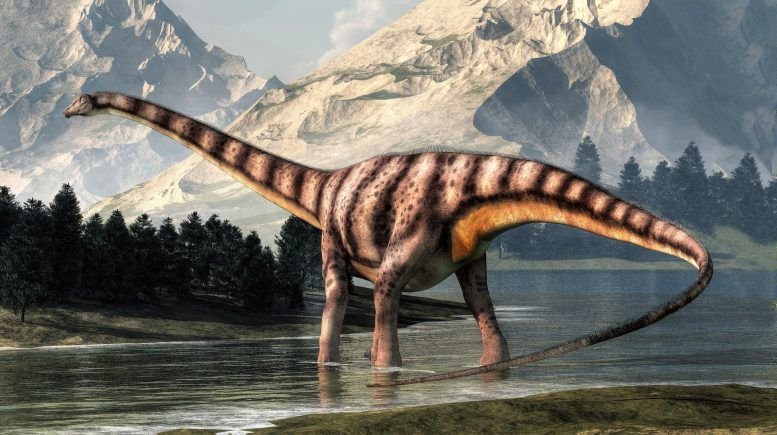Sauropod dinosaurs are known for their large size and long necks and tails. Among sauropods, flagellicaudatan dinosaurs have extremely elongated tails, which has led to theories about their function. Some have compared their tails to whips. In a research published in Scientific Reports, the authors used a 3D model of an apatosaurus flagellicaudatan tail to analyze its motion using multibody simulation and quantify the stress-bearing capabilities of the associated soft tissues.
They found that such an elongated and slender structure would only be able to achieve tip velocities of around 30 m/s, or 100 km/h, due to the combined effects of friction and aerodynamic drag. The material properties of the skin, tendons, and ligaments also support this finding, suggesting that the tail would not have been able to withstand the stresses of traveling at the speed of sound, even if it had a hypothetical "popper" structure similar to the terminal portion of a bullwhip.
The scientists tested whether a model of a sauropod tail could withstand the stress of moving at supersonic speeds. They found that the thin, whip-like tail could not move at a maximum speed of 340 meters per second without breaking. The authors then added three different one-meter-long structures to the end of the model tail to see if they could allow it to travel at the speed of sound without rupturing. These structures included segments made of skin and keratin, a braid of keratin filaments, and a flail-like structure composed of soft tissues. However, none of these structures were able to allow the tail to move at supersonic speeds without rupturing.
Diplodocid Elongated Tails
The elongated tails of diplodocid flagellicaudatan sauropods like Brontosaurus have long been a subject of interest among researchers and enthusiasts. Although no complete tail has been found, overlapping partial findings have revealed that the diplodocid tail consisted of around 80 caudal vertebrae that gradually decreased in size and complexity towards the posterior tip.
Approximately ten large and complex vertebrae formed the base, followed by about 40 intermediate elements, and finally, 30 progressively smaller, rod-like vertebrae. This unique morphology has inspired several hypotheses about the function of the tail, including acting as a "third leg" during bipedal standing, providing a counterbalance to the long neck, providing insertion points for the long caudofemoralis muscle, acting as a defensive weapon, making noise, and serving as a tactile device for spatial awareness. However, some of these theories have been challenged by anatomical evidence.
The elongated tails of diplodocid flagellicaudatan sauropods, such as Brontosaurus, have long been the subject of analysis among researchers and enthusiasts. Some have suggested that the distal portion of the tail could be used as a defensive weapon, due to its morphological similarity to a bullwhip.

Diplodocus was a genus of diplodocid sauropod dinosaurs whose fossils were first discovered in 1877 by S. W. Williston. Diplodocid dinosaurs are known for their long necks and tails; a recent study has suggested that these dinosaurs may have been able to produce a supersonic boom by whipping their tails at high speeds.
ALSO READ: Diplodocid Dinosaur Remains in Montana Shows Signs of 150 Million-Year-Old Respiratory Infection
Testing the "Popper" Structure
In previous studies, computer simulations have been used to test this hypothesis, but the results have been mixed. In this study, the authors used a novel approach combining multibody modeling with simulations of soft tissue resistance to stress to re-assess diplodocid tail motion and speed. They found that the tail would not have been able to withstand the stresses of traveling at the speed of sound, even with a hypothetical "popper" structure at the end. These findings provide insight into the potential function and capabilities of diplodocid tails.
The tail morphology of diplodocid dinosaurs varies, with diplodocus generally having more elongated vertebral centra throughout the tail compared to apatosaurus. However, because the complete diplodocid tails are known from apatosaurus, and because previous models were based on apatosaurus morphology, they also focused their analysis on this taxon.
They used multibody modeling to create a 3D model of an apatosaurus tail, with masses representing the vertebrae placed at their centers of mass. The resulting model had 82 centroids, divided into 14 sections of multiple equal elements. The position of the joints was set based on the shape of the elements and the dimensions of the cartilaginous intervertebral discs, resulting in a total tail length of 12.44 m and a total weight of 1446.16 kg. The center of mass of the whole model was located between the fifth and sixth caudal vertebrae.
Diplodocid Tail Morphology
It is impossible to confirm or deny the presence of a "popper" at the end of the sauropod tail based on the lack of fossil evidence. However, it is possible to speculate about what such a structure might be made of, such as skin, tendon, and keratin. Researchers have conducted tests to determine how different hypothetical morphologies of a popper might withstand the stress of moving at the speed of sound.
These morphologies include a popper divided into three segments, a popper made of keratinous filaments connected to different posterior vertebrae, and a flail-like structure with an additional mass at the end of the tail, based on a released analysis on Science Direct.
The movement of the tail base creates a wave that results in a rotational movement of the last elements, similar to the behavior of a whip. As the wave reaches the end of the tail, its velocity increases due to the tail's mass and cross-section decrease.
However, adding an element that simulates the articulation of the tail to the sacrum limits the range of rotation of the first caudal vertebra, reducing the tail's maximum velocity. Adding air drag to the model further reduces the maximum speed achieved, which is slower than the speed of sound in standard air.
RELATED ARTICLE: Crocodile-Like Beast That Roamed In Tanzania 240 Million Years Ago Discovered, Gets New Name
Check out more news and information on Paleontology in Science Times.














